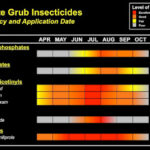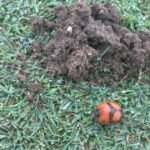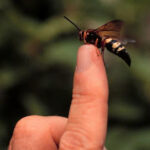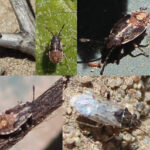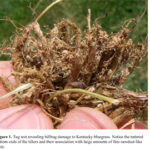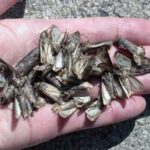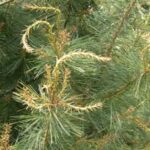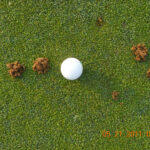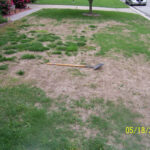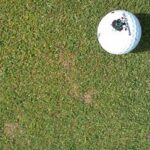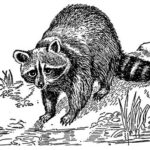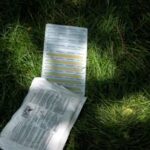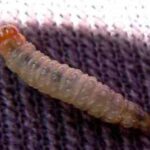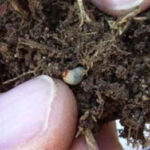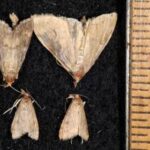Category: Pest Control
Japanese Beetle Emergence Begins
We captured the first Japanese beetle adults of the year last week in our traps on the Purdue Campus. These traps are located in an area where emergence tends to take place much earlier than at most locations, so don’t expect to see any significant wide-scale emergence for another 2-3 weeks. We monitor this particular […]
Black Cutworms Making Their Annual Migration North
Black Cutworms have started showing up in light traps around Indiana. This means they will soon laying eggs, if they haven’t already. Superintendents should be on the lookout for evidence of feeding damage on greens and tees. Also, remember that a soap flush of vulnerable, short-cut areas will often reveal the presence of black cutworms […]
When a GPS Unit Malfunctions
This photo was submitted from a golf course where it was found tunneling into a green. It is obvious that it is creating some damage but the astute manager was able to find and photograph the beetle in association with the damage. This combination always makes identification and control recommendations much easier. The insect was […]
Cicada killers are Wimps
Spread the word – Cicada killers are wimps! Unfortunately, because of their size and the fact that they often live in lawns and landscapes close to where people live, cicada killers evoke a great deal of anxiety. These wasps are huge and look very much like oversized yellow jackets but they have some very important […]
Ground Moving with Tiny Migrating Insects
Whenever I give my ‘General Insect Pest’ presentations I include a couple of photos of chinch bugs and their nymphs. Usually I say something like “These are not pests every year in Indiana but can become troublesome in years when we have a drought.” Guess what? That is now! The dry conditions we are […]
Japanese Beetle Emergence and Management
Below is an e-mail conversation that may be of benefit to other turfgrass managers asking similar questions. Original message: From: Golf Courses Date: Friday, June 22, 9:30 AM To: Gibb, Timothy “Gibb, Timothy” <gibb@purdue.edu> Subject: Japanese Beetles Management in 2012 With the early spring we expected to see early Japanese Beetles. We did […]
Early Billbug Damage Reported Across the Midwest
This season continues to challenge our traditional thinking about insect seasonal ecology and management. Indiana and neighboring states are currently witnessing serious billbug infestations with late instar billbug larvae already present in the soil. This activity is easily 2-3 weeks ahead of normal. We advise all turf managers to take a close look at areas […]
Early Spring Insect Update
Not surprisingly, the early spring warm-up has resulted in a frenzy of early season insect activity. We were out in the field earlier this week to get a handle on just how far ahead insect activity may be this year and we were somewhat exasperated by what we found… Billbugs Billbugs are out in […]
Purdue Turf Scientists and Their Work Highlighted in Recent Press Releases
Scientists make turfgrass safer for animals, deadly for insects September 6, 2011 WEST LAFAYETTE, Ind. – The right combination of compounds produced by a beneficial fungus could lead to grasses that require fewer pesticides and are safer for wildlife and grazing animals, according to Purdue University scientists. Read More Purdue ‘tool box’ could be […]
Warning: High Numbers of Black Cutworms in Traps
June 28/11. We are reporting very high numbers of black cutworm moths in traps right now. These numbers are, in fact, higher than we have seen in many years. What this means to you is that there is a possibility that these moths will lay eggs on your turf and the resulting caterpillars may damage […]
Herbicide damage on Spruce and Pine
The Plant and Pest Diagnostic Lab (PPDL) has recently received several samples of Norway spruce and white pine with symptoms that appear to be associated with injury caused by synthetic auxin (growth regulator type) herbicides. Typical off-target symptoms caused by these herbicides can include epinasty (twisting and curling) of the shoot and tips (Fig. 1) […]
Mound Making on Greens and Tees
In addition to earthworms, there are several insects that can create small mounds of soil above the surface of turfgrass. Usually such mounding is of minimal consequence and, in fact, is beneficial to turfgrass environments as it accomplishes the same thing as cultivation, aeration and top-dressing – only on a very small scale. On occasion, […]
The Case of the Dead Zoysia in Southern Indiana
Zoysia grass is a warm-season grass that is being more frequently used in warm, humid and transitional regions. As zoysia is becoming more frequent in our state we are learning more about the pests that attack it. The photograph below was taken of a stand of zoysia in the southern part of Indiana. It was […]
Sod webworms
Sod webworms may cause damage to closely mowed turfgrass early in the spring. Damage, similar to that depicted in the photos below, may be seen on golf tees and greens. The overwintered caterpillars become active when the temperatures warm up in the spring and begin to tunnel and feed. They are mostly active at night, […]
Skunks and Raccoons causing Havoc?
We continue to receive reports of spring-time turfgrass damage caused by raccoons or skunks. These animals are not feeding on the grass but rather are foraging for below ground, high populations of white grubs. As the vertebrates forage, they turn over great clumps of turfgrass resulting in an area that resembles a war zone. Sometimes […]
Spring Grub Control Not Your Best Bet
Spring is almost upon us and overwintering white grubs will soon be emerging from the depths to continue feeding for a short time before they pupate. These overwintering grubs typically spend the frigid months of December – February deep in the soil profile (up to 12 inches deep) to avoid freezing. As soil temperatures begin […]
Fall Time Mole Control
Moles are back in the limelight!. These small subterranean, tunnel-making pests are causing big frustrations for those managing turfgrass and landscapes. Mole damage is most common during the spring and fall. The only two methods of effectively controlling moles are to; (1) use a bait that they are attracted to OR (2) to physically remove […]
Late Season Insects Found in Turfgrass
The following letter and pictures were sent to us for identification. There was a buzz of follow-up letters and communication afterward indicating that maybe this is not just an isolated occurrence. I have enclosed the initial letter, accompanying photographs and the return response in hopes that this is of value to others noticing the same […]
Summer Stress
With a warm and wet summer, we are experiencing decline in some of our turf around the state due to temperatures, disease, insects, and weeds. In response, we are publishing a four part series on this topic to help turfgrass managers respond. Look forward to the following topics over the next two weeks. Part I: […]
Grass Moths Everywhere
If you have walked out on your lawn recently you may have noticed hundreds of small, buff colored, moths flittering here or there as you approach. These may be alarming for both farmers as well as turfgrass managers because they; look like a common corn pest (European Corn Borer) act like a common turfgrass pest […]
